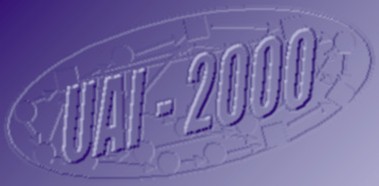

The Sixteenth Conference on Uncertainty in Artificial, UAI-2000, will be held from June 30 - July 3, 2000, at Stanford University. We will be offering, as part of our technical program, three invited talks by distinguished speakers.
We have developed several approaches to the representation and
recognition of human behavior, focusing primarily computer vision. We
divide behaviors into movement, activity, and action. Movements are
the most atomic primitives, requiring no contextual or sophisticated
sequence knowledge to be recognized; movement is often represented and
recognized using either view-invariant or view specific geometric
techniques. Activity refers to sequences of movements, represented
primarily by statistical descriptions; much of the recent work in
gesture understanding falls within this category of behavior
recognition. Finally, actions are larger scale events that typically
include interaction with the environment and causal relationships;
action understanding straddles the division between perception and
cognition, computer vision and artificial intelligence/cognitive
science. Fundamental questions underlying these techniques include
how is time represented, what is the relationship between structural
and statistical representations of behavior, and can the recognition
of high level actions - involving, for example, intentionality - be
achieved by compiled visual routines. I will present examples of our
work in each of these areas covering domains ranging from the
recognition of aerobics movements, to recovering parametric gestures,
to visual surveillance, to interpreting football plays. I will also
show video of some interactive spaces that leverage the techniques
described.
In collaboration with: Alex Gray, Leemon Baird, Dan Pelleg, Mary Soon Lee, Remi Munos, Jeff Schneider, Bob Nichol, Andy Connolly (U Pitt), Alex Szalay (JHU), Leslie Kaelbling (MIT).
UAI represents a thriving area on the border of Computer Science and Statistics. This talk is about a somewhat different set of activities on a somewhat different part of the same border.
This talk is about the algorithmic challenges involved in allowing scientists and engineers to continue using the modeling and inference tools they've been happily applying to kilobytes of data, when they start drawing in gigabytes of data. My main examples will be collaborations with astrophysicists, with a few high throughput screening and engineering experiences thrown in for variety.
I will try to give a roadmap to the various literatures and tools from computational geometry, numerical analysis, databases and AI.
The technical meat of the talk will highlight some new algorithms and data structures that fall into the class of "cached sufficient statistics." These are summary data structures that live between the statistical algorithm and the database, intercepting the kinds of operations that have the potential to eat up valuable time if they were answered by direct reading of the dataset. Some structures may be familiar (kd-trees and R-trees, for example) while some are new (All-dimensions trees, the Anchors Hierarchy for high dimensions and the Airports Hierarchy for certain kinds of Markov Decision Process problems), but for all stuctures the search algorithms operating on the cached structures have interesting properties that call for further development.
We will also discuss new developments in collaboration (and led by) Alex Gray here in the Auton Lab (www.cs.cmu.edu/~AUTON) that has the possibility of shortly producing the lab's first billion-fold speedup over a currently fielded astro-statistical discovery program.